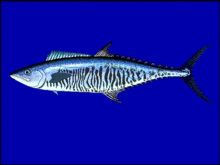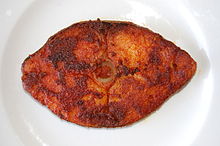
Mackerel is a common name applied to a number of different species of pelagic fish, mostly from the family Scombridae. They are found in both temperate and tropical seas, mostly living along the coast or offshore in the oceanic environment.

The milkfish is the sole living species in the family Chanidae. However, there are at least five extinct genera from the Cretaceous. The repeating scientific name (tautonym) is from Greek khanos.
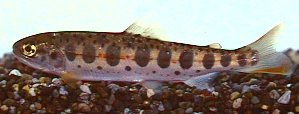
The masu salmon, also known as masu or cherry trout in Japan, is a species of salmonid belonging to the genus Oncorhynchus, found in the North Pacific along Northeast/East Asian coasts from the Russian Far East to south through Korea, Japan and Taiwan. Although generally accepted as a salmon in the West, the fish is actually regarded as a trout in Japan as it is the most commonly seen freshwater salmonid in the Japanese archipelago.

The king mackerelsurmayi or kingfish, is a migratory species of mackerel of the western Atlantic Ocean and Gulf of Mexico. It is an important species to both the commercial and recreational fishing industries.

Philibert Commerson, sometimes spelled Commerçon by contemporaries, was a French naturalist, best known for accompanying Louis Antoine de Bougainville on his voyage of circumnavigation in 1766–1769.

Wahoo is a scombrid fish found worldwide in tropical and subtropical seas. It is best known to sports fishermen, as its speed and high-quality flesh makes it a prized and valued game fish.

The Atlantic Spanish mackerel is a migratory species of mackerel that swims to the northern Gulf of Mexico in spring, returns to southern Florida in the eastern Gulf, and to Mexico in the western Gulf in the fall.

The streaked Spanish mackerel is found mainly in and around India, especially along the Maharashtra and Gujarat coasts. The peak season for fishing this fish is from October to December. It is also known by other names, such as streaked seer, hazard (French), sawara, and carite (Spanish). It is found off Asian coasts from the west coast of India and Sri Lanka east to Java and does not extend east of Wallace's Line. It is an important quarry species for fisheries where it occurs.
The Pacific saury is species of fish in the family Scomberesocidae. Saury is a seafood in several East Asian cuisines and is also known by the name mackerel pike.

The Atlantic horse mackerel, also known as the European horse mackerel or common scad, is a species of jack mackerel in the family Carangidae, which includes the jacks, pompanos and trevallies. It is found in the eastern Atlantic Ocean off Europe and Africa and into the south-eastern Indian Ocean. It is an important species in commercial fisheries and is listed as a Vulnerable species on The IUCN Red List of Threatened Species.
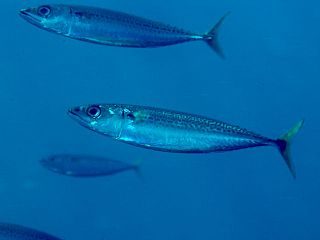
The blue mackerel, also called Japanese mackerel, Pacific mackerel, slimy mackerel or spotted chub mackerel, is a fish of the family Scombridae. It typically reaches 30 cm (12 in) in length and 1.4 kg (3.1 lb) in weight.

Trypanorhyncha is an order of cestodes, a type of flatworm.
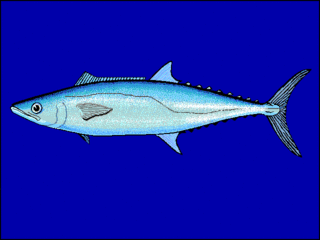
Scomberomorus is a genus of ray-finned bony fish in the mackerel family, Scombridae. More specifically, it is a member of the tribe Scomberomorini, commonly known as the Spanish mackerels.

Scomberomorini is a tribe of ray-finned saltwater bony fishes that is commonly known as the Spanish mackerels, seerfishes or seer fish. This tribe is a subset of the mackerel family (Scombridae) – a family that it shares with three sister tribes, the tunas, mackerels, and bonitos, and the butterfly kingfish. Scomberomorini comprises 21 species across three genera. They are pelagic fish, fast swimmers and predatory in nature, that fight vigorously when caught. They are mainly caught using hooks and lines.
The Monterrey Spanish mackerel is a species of fish in the family Scombridae. It is endemic to Mexico where it is found in the northern part of the Gulf of California. It is the subject of a fishery, its population is declining and the IUCN has rated it as being a "vulnerable species"

The blue trevally, also known as the banded trevally, barred trevally, Ferdau's trevally or Forskaal's jackfish, is a common, widespread species of pelagic marine fish classified in the jack family, Carangidae. The blue trevally is distributed throughout the tropical and subtropical waters of the Indo-Pacific and central Pacific regions, ranging from South Africa in the west to Hawaii in the east. It is a moderately large fish, growing to a recorded maximum length of 70 cm, with the number of rays in the second dorsal fin and the colouring serving as diagnostic features of the species. The species inhabits waters to depths of 60 m, generally inhabiting reefs, beaches, lagoons, and areas with sandy substrates. It is a predatory fish, taking other fish, prawns, crabs, and molluscs, and very little is known of the species' reproductive biology. The blue trevally is of varying importance to fisheries throughout its range, with some regions having high catches of the fish. It is considered to be a gamefish, and is sought after for its excellent eating qualities.

The Indian mackerel is a species of mackerel in the scombrid family of order Perciformes. It is commonly found in the Indian and West Pacific oceans, and their surrounding seas. It is an important food fish and is commonly used in South and South-East Asian cuisine.

The Chilean jack mackerel, sometimes called the Inca scad or Peruvian jack mackerel, is a species of jack mackerel in the genus Trachurus of the family Carangidae. Since the 1970s, it has become one of the world's more important commercial fish species. High volumes have been harvested, but the fishery may now be in danger of collapsing.

The Japanese Spanish mackerel, also known as the Japanese seer fish, is a species of true mackerel in the scombrid family (Scombridae). Their maximum reported length is 100 cm, and the maximum reported weight is 10.57 kg.
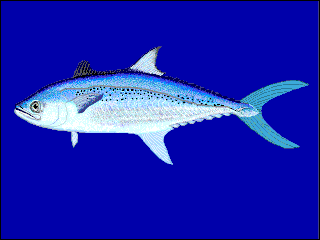
The Korean mackerel also known as the Korean seerfish, is a ray-finned bony fish in the family Scombridae, better known as the mackerel family. Within that family, this fish is a member of the tribe Scomberomorini, the Spanish mackerels. It has an Indo-Pacific distribution which extends from the east coast of India and Sri Lanka along the Asian continental shelf to Sumatra, then north to Korea and Wakasa Bay in the Sea of Japan. This species is of minor commercial importance in some parts of its range, where it is taken using gill nets and is marketed either fresh or dried-salted. The Korean mackerel is an important quarry species for the drift net fishery in Palk Bay and the Gulf of Mannar in India.
